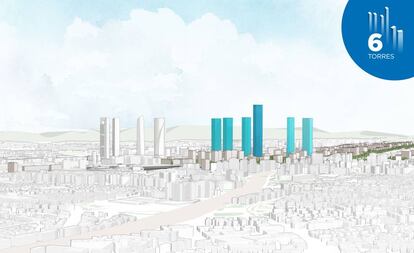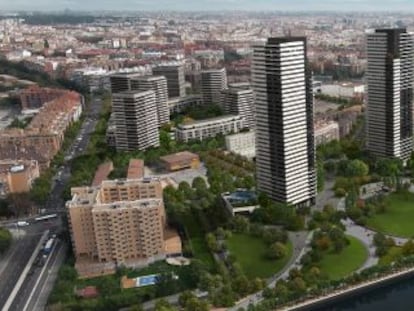Is Madrid about to get the European Union’s tallest skyscraper?
Developer is planning six-tower complex in north of capital, but still lacks municipal permits

A developer is planning to build the European Union’s tallest skyscraper in Madrid.
The 70-floor building would go up in the Chamartín district of the capital, and be part of a larger six-tower complex planned by Distrito Castellana Norte (DCN), said company CEO Antonio Béjar on Wednesday.
We’ve been investing a lot of years and money into this. Our goal is to keep moving forward
Antonio Béjar, CEO of DCN
The new buildings are slated for construction near four existing skyscrapers known as Las Cuatro Torres, whose 52-floor Torre Cristal, standing at 250 meters, is currently Madrid’s tallest tower.
Béjar said that the project “will redesign the city’s skyline and place Madrid among the main European capitals.”
The announcement was made at the Sustainable City Planning Forum, organized by EL PAÍS and sponsored by DCN and BBVA bank, the developer’s major stakeholder.
According to Béjar, the six new towers “make up a balanced and sustainable urban setting.”
A project 20 years in the making
Béjar said the project has all necessary authorizations and technical approval reflected in 48 favorable reports. But it still lacks a municipal license. Béjar said that his company has not sent an ultimatum to city authorities, but that he hopes to get a reply before the end of this year.
“This real estate operation is more alive than ever; the start of construction work has never been closer. We have suffered political changes for two decades, but now we’re just waiting for a municipal license,” said Béjar.
The project is, in fact, 20 years old. Controlled by BBVA (with a 75.5% stake) and construction firm San José (24.5%), the company in charge of it was renamed Distrito Castellana Norte (DCN) in 2014 to overcome a series of legal hurdles.
DCN complains
A month ago, DCN filed a complaint with the city of Madrid, accusing the department of sustainable city planning of trying to paralyze the project.
City officials had organized a discussion panel with neighborhood associations and local residents, a move that DCN feels “clearly violates” the law.
In February, the city had granted preliminary approval for the development. But local elections in May changed the makeup of the government, with the Popular Party (PP) losing power to a leftist administration led by Manuela Carmena.
Since then, final approval has been “effectively paralyzed,” according to DCN.
Béjar said that in his opinion, the project meets all requirements set out in city zoning legislation, particularly with regard to how much land may be built on.
“We’ve been investing a lot of years and money into this,” he said. “Our goal is to keep moving forward.”
The developer plans to extend the northern end of Paseo de la Castellana by a further 3.7km, bringing it all the way up to the M-40 ring road. It also wants to redesign a 311-hectare tract of land that would contain 17,699 homes, green areas totaling half the size of Retiro Park, and the towers themselves.
The plan represents a €6 billion investment by the owners, and would create 120,000 new jobs, according to DCN estimates. The company also says the city would benefit from €3.3 billion in taxes throughout the project.
Around 80% of the land (over 1.3 million square meters) would be turned over to public spaces and green areas, with the remaining 20% reserved for housing, commercial premises and office space.
The developer is also proposing improvements to transportation in the area, suggesting the need for new subway and commuter train stops, and new cycling paths.
DCN said the project “offers solutions to the problems of Madrid’s northern area and its residents.” Its CEO also claimed that 78% of Madrileños and 83% of nearby residents have a good or very good opinion of the project, according to several surveys.
English version by Susana Urra.
Sign up for our newsletter
EL PAÍS English Edition is launching a weekly newsletter. Sign up today to receive a selection of our best stories in your inbox every Saturday morning. For full details about how to subscribe, click here.
Tu suscripción se está usando en otro dispositivo
¿Quieres añadir otro usuario a tu suscripción?
Si continúas leyendo en este dispositivo, no se podrá leer en el otro.
FlechaTu suscripción se está usando en otro dispositivo y solo puedes acceder a EL PAÍS desde un dispositivo a la vez.
Si quieres compartir tu cuenta, cambia tu suscripción a la modalidad Premium, así podrás añadir otro usuario. Cada uno accederá con su propia cuenta de email, lo que os permitirá personalizar vuestra experiencia en EL PAÍS.
¿Tienes una suscripción de empresa? Accede aquí para contratar más cuentas.
En el caso de no saber quién está usando tu cuenta, te recomendamos cambiar tu contraseña aquí.
Si decides continuar compartiendo tu cuenta, este mensaje se mostrará en tu dispositivo y en el de la otra persona que está usando tu cuenta de forma indefinida, afectando a tu experiencia de lectura. Puedes consultar aquí los términos y condiciones de la suscripción digital.
More information
Últimas noticias
Most viewed
- Pablo Escobar’s hippos: A serious environmental problem, 40 years on
- Reinhard Genzel, Nobel laureate in physics: ‘One-minute videos will never give you the truth’
- Why we lost the habit of sleeping in two segments and how that changed our sense of time
- Charles Dubouloz, mountaineering star, retires at 36 with a farewell tour inspired by Walter Bonatti
- The Florida Keys tourist paradise is besieged by immigration agents: ‘We’ve never seen anything like this’











































